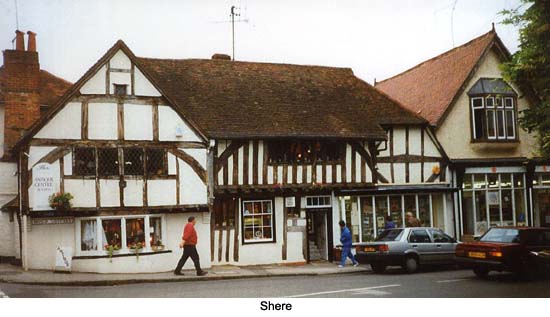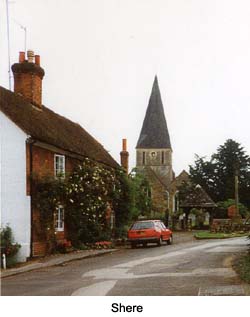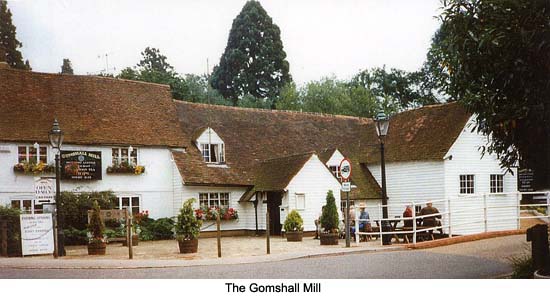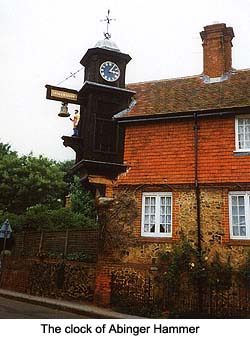The Villages of Surrey
by Jean E. Bellamy
Situated in the Tillingbourne Valley between Dorking and
Guildford lie the Saxon villages of Shere ("Essira" in
the Domesday Book of 1086) and nearby Gomshall (Gomesele), on the
A25. Today Shere, known as the "Home of Art," is a
venue for painters and possesses a number of fascinating old
house and inns. Its ancient and picturesque parish church
dedicated to St. James was built in 1190 in the Early English
style and has a fine brooch spire and varied stonework. Said to
be one of the most beautiful and historic village churches in
Surrey, it is of much interest architecturally and has been a
place of pilgrimage for 1000 years.

Worth looking out for in the church is quatrefoil and squint
window in the north wall of the chancel, which has an unusual
story connected with it. Onto this was built in 1329 the
Anchoress's Cell, where a girl named Christine, daughter of
William the Carpenter, was enclosed for three years. The Bishop
of Worcester gave permission for her to be thus incarcerated
though the space was barely large enough to accommodate her,
small though she was. During the whole of this time her only
contact with the outside world was the squint, through which she
was able to view the proceedings at Holy Communion and receive
the bread and wine. Food and drink were supplied in the same
manner, and thus she remained until eventually deciding she
needed a break! She later returned to the cell and is believed to
have died there.
 Another feature of interest in this church is a brass
of date 1491 to Lord Audley, a knight, whose son James, a leader
of the Cornish Rebellion of 1497, rode his mount through Shere on
his way to Blackheath and was later beheaded at Tower Hill. Also
worth noting are the bricks in the churchyard wall, which bear
the initials of villagers responsible for the upkeep of those
parts. The lychgate was designed by Sir Edwin Lutyens in 1902. Another feature of interest in this church is a brass
of date 1491 to Lord Audley, a knight, whose son James, a leader
of the Cornish Rebellion of 1497, rode his mount through Shere on
his way to Blackheath and was later beheaded at Tower Hill. Also
worth noting are the bricks in the churchyard wall, which bear
the initials of villagers responsible for the upkeep of those
parts. The lychgate was designed by Sir Edwin Lutyens in 1902.
Building and rebuilding occurred extensively from 1580 to 1640
and many timber-framed edifices may be seen in Shere today. The
Old Forge, once owned by Oliver Sands, remained in the possession
of the Bonds, a notable Surrey family having graves in the
church, for well over 100 years. In 1771 it passed to William
Bray, a member of a family prominent locally in the 16th and 17th
centuries, while in the early 1800s it appears to have been
occupied by Bristowe's Butcher shop, and later Puttock the
Blacksmith.
Worth looking out for, too, is the old wall and well, the former
running from Elm Cottage in Upper Street to Manor Cottage, and
from thence round to Middle street to Forge Cottage, built by
William Bray in 1772. The well, 286 feet in depth, was dug in
1886 and presented to the village by the Misses Spottiswoode of
Drydown. A plaque states that water flowed here until the 1970s,
when Thames Water sunk fresh bore holes in the area, thus
lowering the water table 18 inches. and stopping the spring. In
1984 many local people subscribed to the refurbishment of the
well as an ornamental asset to the village and its many visitors.
Another unusual feature is a gargoyle on the downpipe of a
building dating from 1620.
Once noted for smuggling and sheep-stealing, Shere became famous
for its cotton industry, which involved the weaving of fustian --
a mixture of cotton, linen and flax. The Spinning Walk and the
Rack Close on the southern edge of the village remain as a
reminder of these times.
Not to be missed whilst in the vicinity is the mysterious Silent
Pool lying just off the Shere bypass, the latter opened in 1960.
The pool, reached by way of a wooden gate and along a track, is
surrounded with vegetation and overhung by huge silver beeches.
Apparently greatly admired by the poet Tennyson, the crystal
stretch of water consists of an upper and a lower lake that
swarms with tame trout. It is said never to have been frozen over
and is of such extreme cleanliness that, according to legend,
even a mystic maiden who drowned herself there can be clearly
seen at midnight -- still drowning!

Just above Shere, Gomshall in its picturesque setting beside the
Tillingbourne stream, draws visitors from all over the world.
Behind a 16th century packhorse bridge bearing the sign WEAK
BRIDGE stands the village's most noteworthy feature -- a 17th (or
possibly 16th) century) timber-framed mill with later extension.
Believed to occupy the site of an earlier mill referred to in the
Domesday Book as "Gomsele," it ceased its corn-grinding
function in the 1950s, when it was converted into a restaurant
and shop. Whilst visiting here, a feature to note is the interior
18th century water-wheel.
 To north and south of the village lie the attractive wooded
countryside comprising the North Downs and the Hurtwood, a name
derived perhaps from "Hartwood" or deer forest. Here
are many paths and bridleways that provide opportunity for
leisure enjoyment. To the north, the Hackhurst Downs rise to a
height of over 700 feet and a granite boulder marks the spot
where Samuel Wilberforce, Bishop of Winchester and son of William
Wilberforce, was fatally injured when thrown from his horse in
1873.
To north and south of the village lie the attractive wooded
countryside comprising the North Downs and the Hurtwood, a name
derived perhaps from "Hartwood" or deer forest. Here
are many paths and bridleways that provide opportunity for
leisure enjoyment. To the north, the Hackhurst Downs rise to a
height of over 700 feet and a granite boulder marks the spot
where Samuel Wilberforce, Bishop of Winchester and son of William
Wilberforce, was fatally injured when thrown from his horse in
1873.
Just southeast of Gomshall and south of Shere is Abinger Hammer,
originally known as Shere Hammer. Though not old, this attractive
hamlet has connections with the now-vanished iron smelting
industrye. Its most outstanding feature is an unusual clock
overhanging the village street, bearing the motto, "By me
you know how fast to go." Should you chance to pass by at
the right time, you will see Jack the Hammer strike out the time
on his anvil. Given in memory of the first Lord Farrer of Abinger
Hall who died in 1899, this remarkable timepiece, depicting a
blacksmith at his trade, is a reminder of the once-important role
the village and surrounding area played in the Surrey
iron-smelting industry.
Hammer ponds, which were formed by damming the stream at various
points along its course, were required by the ironmasters to
drive the wheels of the watermills that operated the heavy
hammers of the local iron works. At Abinger Hammer today these
ponds (still called "hammer ponds") are utilised by the
watercress growers, the chalk beds being ideal for the purpose.
This is a popular spot in summer, with cricket being played on a
pitch beside the road -- though the narrowness of the main road
running through the village causes problems, particularly if you
should wish to stop and photograph the clock!
More Information:
We regret that we no longer have the resources to maintain up-to-date links and/or hours and pricing details for the various sites and attractions listed on this website. For more information about the location(s) listed above, please use your favorite search engine or visit Wikipedia.
Jean Bellamy has been writing since 1970, and is the author of over 300 published articles and short stories. She has written three children's novels (all with a "West Country flavour"). A resident of Dorset, she is the author of several local history books, including Treasures of Dorset, A Dorset Quiz Book, Second Dorset Quiz Book, Dorset Tea Trail, Dorset as she was spoke, Little Book of Dorset, 101 Churchces in Dorset, and Cornwall: A Look Back. Jean loves to explore and write on all things British.
Article and photos © 2006 Jean Bellamy
|
